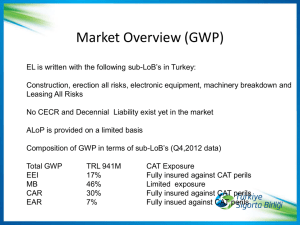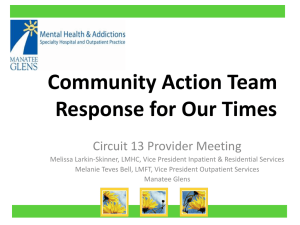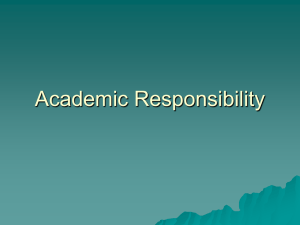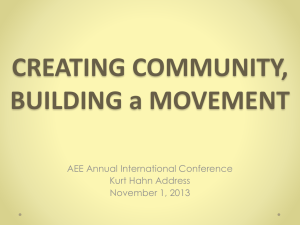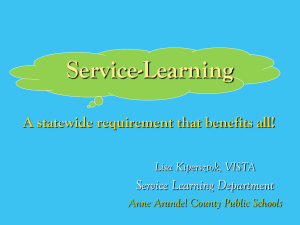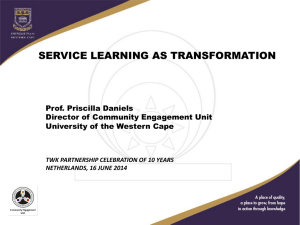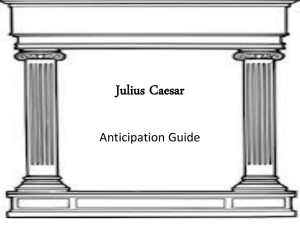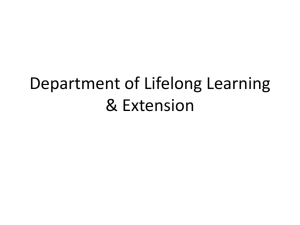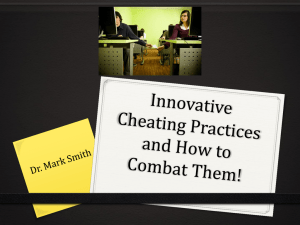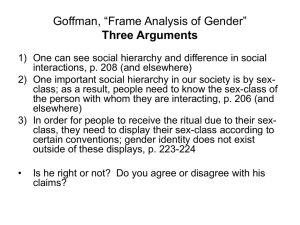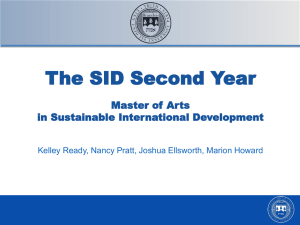Student development and experiential learning impact
advertisement
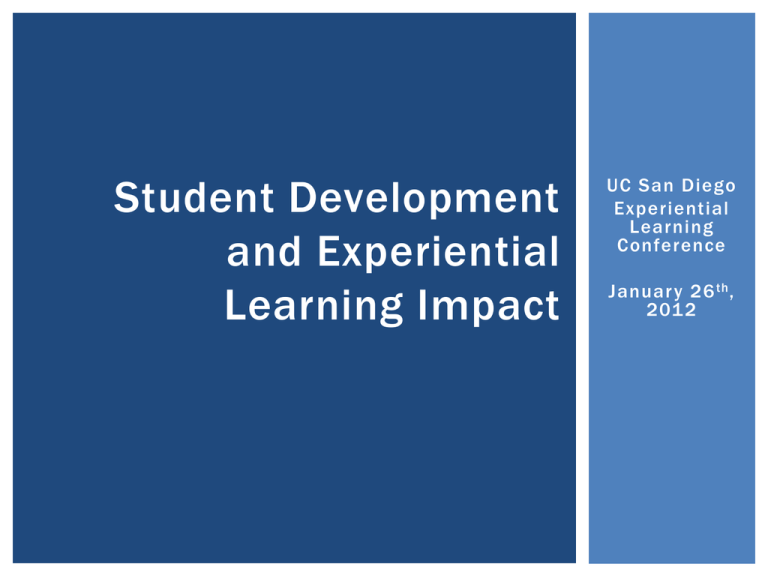
Student Development and Experiential Learning Impact UC San Diego Experiential Learning Conference Januar y 26 th , 2012 SESSIONS From Community Service to Service Learning: Unlocking the Educational Impact of Student Service Activities Penny Rue V i c e C h a n c e l l o r, S t u d e n t A f f a i r s Student Expectations and Workforce Realities: Experiential Learning from an Employer Perspective Andy Ceperley A s s i s t a n t V i c e C h a n c e l l o r, E x p e r i e n t i a l L e a r n i n g D i r e c to r, C a r e e r S e r vi c e s C e n te r Sixth College Practicum Assessment Diane A. Forbes Ber thoud P r a c t i c u m D i r e c to r, S i x t h C o l l e g e Daisy Rodriguez P r a c t i c u m P r o g r a m C o o r d i n a to r, S i x t h C o l l e g e Academic Integrity: Making Meaning from the Experience of Cheating Patricia Mahaffey Dean of Student Affairs, Muir College From Community Service to Service Learning: Unlocking the Educational Impact of Student Service Activities Penny Rue, Ph.D. Vice Chancellor, Student Affairs University of California, San Diego Corporation for National Service P re s i d ent ’s H i g h er E d u c at i on C ommu ni t y Se r v i c e H onor Rol l of Di s t i nc t i on: U n i ver s it y o f C a l i forni a, S a n D i e g o Scope, innovativeness, and evidence of effectiveness of the service Level of student participation in service activities The institution's Federal Work -Study community service participation rate. Whether the institution has at least one fulltime staff member responsible for coordinating student community service. Whether the institution provides scholarships as a reward for service, such as "matching" the Segal AmeriCorps Education Award. The extent to which the institution offers academic service -learning courses. Whether the institution requires service -learning courses as part of the core curriculum of at least one major or discipline. Whether the institution rewards the use of service-learning by faculty. Chancellor’s Challenge Volunteer 50 Clinton Global Initiative – University comes to UC San Diego Chancellor funds partnership b et w e e n S t u d e n t A f f ai r s a n d Re s e a r c h A f f a i r s to p a i r s t u d e n t s w i t h f a c ul t y to enact their c o m m it m e n t s What Service-Learning Looks Like If students collect trash out of an urban stream bed, they are providing a valued service to the community as volunteers. If students collect trash from an urban stream bed, analyze their findings to determine the possible sources of pollution, and share the results with residents of the neighborhood, they are engaging in service-learning. In the service-learning example, in addition to providing an important service to the community, students are learning about water quality and laboratory analysis, developing an understanding of pollution issues, and practicing communications skills. They may also reflect on their personal and career interests in science, the environment, public policy or other related areas. Both the students and the community have been involved in a transformative experience. Wingspread’s Principles of Good Practice for Combining Service and Learning 1. An ef fective program engages people in responsible and challenging actions for the common good. 2. An ef fective program provides structured oppor tunities for people to reflect critically on their ser vice experience. 3. An ef fective program ar ticulates clear ser vice and learning goals for ever yone involved. 4. An ef fective program allows for those with needs to define those needs. 5. An ef fective program clarifies the responsibilities of each per son and organization involved. 6. An ef fective program matches ser vice providers and ser vice needs through a process that recognizes changing circumstances. 7. An ef fective program expects genuine, active, and sustained organizational commitment. 8. An ef fective program includes training, super vision, monitoring, suppor t, recognition, and evaluation to meet ser vice and learning goals. 9. An ef fective program insures that the time commitment for ser vice and learning is flexible, appropriate, and in the best interests of all involved. 10. An ef fective program is committed to program par ticipation by and with diverse populations. A Service and Learning Typology 1. service learning 2. Service-LEARNING 3. SERVICE-learning 4. SERVICE-LEARNING 1. Service and learning goals separate 2. Learning goals primary; service outcomes secondary 3. Service outcomes primary; learning goals secondary 4. Service and learning goals of equal weight; each enhances the other for all participants High impact programs and outcomes Program Characteristics Placement quality Application Reflection: writing Reflection: discussion Diversity Community voice Service Learning Outcome Personal development Interpersonal development Closeness to faculty Citizenship Learning, understanding, applying Problem-solving, critical thinking Stereotyping, tolerance Perspective transformation Enhancing Intercultural Competence Through Civic Engagement 1. Provide a thorough introduction to the community 2. Work to dispel myths and negative, inaccurate stereotypes 3. Consider the multidimensionality of the social factors and systemic issues affecting the community 4. Take into account the intragroup diversity that exists between the community and those engaged with the community 5. Attempt to develop trust gradually and over extended period of time International engagement Institutional Organization and Transformation Organizational structures evolve based upon mission, strategy, and/or leadership Universities with renowned servicelearning programs utilize differing models Strong academic leadership enhances faculty involvement Regardless of model, coordination of efforts is essential Coordinated community engagement beyond student volunteer service enhances the role of the University in the community Leveraging and building upon existing service and service learning programs can create a more strategic relationship with local and state governments and civic organizations References Astin, A. Vogelgesang, L,.J. Ikeda, E.K. and Yee, J.A. (2000). How service learning affects students . Los Angeles: Higher Education Research Institute, UCLA. Delve, C.I., Mintz, S.D. and Stewart, G.M. (1990). Promoting values development through community service: A design. In Delve, C.I., Mintz, S.D. and Stewart, G.M. (Eds.) Community service as values education. New Directions for Student Services, 50. San Francisco: Jossey-Bass. Dunlap, M.E. and Webster, N. (2009). Enhancing intercultural competence through civic engagement. In . In Jacoby, B. (Ed.), Civic engagement in higher education: Concepts and practices . San Francisco: Jossey Bass. Eyler, J.S. and Giles , D.E. (1999). Where’s the learning in service -learning? San Francisco: Jossey-Bass. Eyler, J.S., Giles, D. E., Stenson, C.M. and Gray, C.J.( 2001). At a glance: What we know about the effects of service learning on college students, faculty, institutions and communities, 1993 -2000: Third Edition. Nashville, TN: Vanderbilt University. Global Health Minor (2012). Retrieved January 22, 2012, from http://roosevelt.ucsd.edu/global health/index.html. Keen, C. and Hall, K. (2009). Engaging with difference matters: Longitudinal student outcomes of co curricular service-learning programs. The Journal of Higher Education , 80, (1), pp. 59 -79. Kuh, G.D. (2008). High Impact educational practices: What they are, who has access to them, and why they matter. Washington, DC: AAC&U. Mintz, S.D. and Hesser, G.W. (1996). Principles of good practice in service -learning. In Jacoby, B. (Ed.), Service Learning in higher education. San Francisco: Jossey Bass. National Service-Learning Clearinghouse (2012). Washington, D.C.: Corporation for National Service. Organizing, defining and assessing service -learning programs (2010.) Custom research brief. Washington, D.C. Education Advisory Board Student Affairs Leadership Council. Pizga, J.M. and Troppe, M.L. (2003). Developing an infrastructure for service -learning and engagement. In Jacoby, B. (Ed.), Building partnerships for service Learning. San Francisco: Jossey Bass. Sigmon, R. (1996). The problem of definition in service -learning. In R. Sigmon et al., The journey to service-learning. Washington, D.C.: Council of Independent Colleges. From Community Service to Service Learning: Unlocking the Educational Impact of Student Service Activities Penny Rue, Ph.D. Vice Chancellor, Student Affairs University of California, San Diego Student Expectations & Workforce Realities: Experiential Learning from an Employer Perspective Andy Ceperley Assistant Vice Chancellor, Experiential Learning Director, Career Ser vices Center University of California, San Diego Experiential Learning and Recent UC San Diego Graduates Graduates’ Chosen Fields of Employment Most Popular Strategies Used to Secure Employment 1. Internships/previous work experience (29%) 2. Employer websites and direct employer contact (22%) 3. Online job boards and Port Triton (20%) 4. Networking (14%) What Students Want in Their First Jobs 1. Opportunity for personal growth 2. Job Security 3. Employee Benefits 4. Friendly co-workers 5. High starting salary 6. Chance to improve community 7. Recognition for performance 8. Location close to home 9. Opportunity for rapid advancement 10.Diversity Employers’ Hiring Priorities A student’s academic major and leadership experience are meaningful influencers on employers’ hiring decisions 73% of employers screen by GPA Relevant work experience represents the highest influencer employers are seeking in college graduates (76%) Attribute % of respondents Ability to work in a team 79.8% Leadership 77.2% Communication skills (written) 75.6% Problem-solving skills 74.1% Strong work ethic 73.1% Analytical/quantitative skills 72.0% Communication skills (verbal) 67.4% Initiative 65.3% Technical skills 61.1% Detail-oriented 57.5% Flexibility/adaptability 56.0% Computer skills 55.4% Interpersonal skills (relates well to others) 54.9% Organizational ability 50.8% Strategic planning skill 29.0% Friendly/outgoing personality 29.0% Creativity 22.3% Entrepreneurial skills/risk-taker 21.8% Tactfulness 21.2% Resume Reviews: Top Attributes Employers Seek Student Affairs Learning Outcomes Framework 1. Intrapersonal, interpersonal, and intergroup competencies 2. Social justice and community responsibility 3. Personal skill development 4. Effective communication 5. Intellectual growth 6. Leadership skills References U C S a n D i e g o S t ude n t A f f a i r s L e a r n i n g O u t c o me s Fr a m ew o rk ( 2 01 0 ) h t t p : / / s t ud e n t s . uc s d . e d u/ s t ud e n t - l ife / _ o r g a ni z a t io n s / s t ud e n t - a f f ai r s / s t r a t - p l a n . h t ml . U C S a n D i e g o S u r vey o f Re c e n t G r a d u a te s ( 2 01 0 ) h t t p : / / c a r e e r.uc s d . e d u/ al um n i / a l um ni - s ur v ey / i n d ex .h t m l . N AC E Re s e a r c h C l a s s o f 2 01 1 S t u d e n t S u r vey Re p o r t w w w.n a c ewe b . o r g . N AC E Re s e a r c h J o b O u t l o o k 2 01 2 w w w. n a c ewe b .o r g . Student Expectations & Workforce Realities: Experiential Learning from an Employer Perspective Andy Ceperley Assistant Vice Chancellor, Experiential Learning Director, Career Ser vices Center University of California, San Diego Sixth College Practicum Assessment Diane A. Forbes Berthoud Practicum Director Daisy Rodriguez Practicum Program Coordinator University of California, San Diego Sixth College Practicum Unique to the Sixth College curriculum Sixth College upper-division GE requirement Integration of theory and practice by making connections between classroom learning and community experiences Sixth College Practicum Research reveals that students greatly benefit from experiential learning: Essential leadership skills Better communication skills Increased self-awareness Enhanced multicultural and global understanding Sixth College Student Enrollment Practicum Courses 2010-2011 Programs Abroad 0.40% CAT 124 Other Preapproved & Unapproved courses 21% MAE 171 A&B 1% INTL 190 3% Independent and Special Studies 14% MGT 121 A & B 7% AIP 197 8% TIES CAT 124 18% EDS TIES 6% EDS 22% AIP 197 Independent Studies & Internships MGT 121 A & B INTL 190 MAE 171 A&B Programs Abroad Assessing Experiential Learning at Sixth Pre- and Post-Practicum Survey Modified from a Rockquemore and Schaffer (2000) study Measures attitudinal changes in students, their learning process, and how that process is unique to experiential learning Pre- and Post- Practicum Survey 1. 2. 3. 4. 5. 6. 7. 8. 9. 10. 11. 12. 13. 14. 15. 16. 17. 18. 19. 20. 21. 22. 23. 24. I have a realistic understanding of the daily responsibilities involved in the jobs (career) in which I am interested. I am motivated by courses that contain hand-on applications of theories to real-life situations. I am uncertain of what’s required to succeed in the career that I want to pursue. I feel I can make a difference in the world. There is little I can do to end discrimination on the basis of gender, race, sexual orientation, or any other identity. I learn the course content best when connections to real-life situations are made. It is important to find a career that directly benefits others. I am an active member of my community. It is important that I work toward equal opportunity for all people. I make very few assumptions about others. I think that people should find time to contribute to their community. It is not necessary for me to volunteer my time. There is no relation between my real life experiences and what I learn in school. I have a good understanding of the needs and concerns of the community in which I live. The world would be a better place if differences between people were ignored. I have a good understanding of the strengths and resources of the community in which I live. I possess the necessary personal qualities (e.g. responsibility, consideration, initiative, etc.) to be a successful career person. I feel I can have a positive impact on local social problems. The things I learn in school are not applicable to my life outside of school. To be effective in the community, all you need is a caring heart. I feel uncomfortable presenting/ speaking in front of a group of individuals in positions of authority. Being involved in a program to improve my community is important to me. I do not feel well prepared to embark on my post-graduate plans (e.g. graduate school, employment, etc.) I have very little impact on the community in which I live. Strongly agree Somewhat agree Strongly disagree 1 2 3 4 5 6 1 2 3 4 5 6 1 1 1 2 2 2 3 3 3 4 4 4 5 5 5 6 6 6 1 1 1 2 2 2 3 3 3 4 4 4 5 5 5 6 6 6 1 1 1 2 2 2 3 3 3 4 4 4 5 5 5 6 6 6 1 2 3 4 5 6 1 2 3 4 5 6 1 2 3 4 5 6 1 2 3 4 5 6 1 2 3 4 5 6 1 1 2 2 3 3 4 4 5 5 6 6 1 2 3 4 5 6 1 2 3 4 5 6 1 2 3 4 5 6 1 2 3 4 5 6 1 1 2 2 3 3 4 4 5 5 6 6 Practicum Pre- and PostSurvey Student Participation Spring 2011 CAT 124 Courses Offered CAT CAT CAT CAT CAT 124: 124: 124: 124: 124: Torrey Pines Elementary Urban Discovery Academy Coaching the Craft of Writing Online Tutoring Spanish Civil War Memory Project 48 students (21%) enrolled in CAT 124 courses Pre-Survey: 44% Response Rate Post-Survey: 35% Response Rate Student Participation Summer & Fall 2011 CAT 124 Courses Offered Summer 2011 CAT 124: Solar Energy and Student Life 33 students (48%) enrolled in CAT 124 course Pre-Survey: 55% Response Rate Post-Survey: 42% Response Rate CAT 124 Courses Offered Fall 2011 CAT 124: Coaching the Craft of Writing CAT 124: Online Tutoring 19 students (9%) enrolled in CAT 124 courses Pre-Survey: 58% Response Rate Post-Survey: 53% Response Rate Pre- and Post-Survey Themes Career preparedness and success Attitudes towards community service and civic responsibility Academic connection to life Attitudes towards equality of opportunity Connection between career and community Understanding of community resources Attitudes towards social justice CAT 124 Spring 11 Data Impact: Career Preparedness & Success Understanding of responsibilities of career (Q1) 57% 77% Possession of personal qualities to be successful (Q 17) Uncertainty of requirements for career success (Q 3) 85% 100% 48% 24% 0% 20% 40% 60% 80% 100% Percentage PreSurvey PostSurvey CAT 124 Spring 11 Data Impact: Attitude Change Toward Community Service & Civic Responsibility Need for caring heart to be effective in the community (Q 20) 48% 24% 67% It is not necessary for me to volunteer my time (Q12) Disagree 88% I think that people should find time to contribute to their community (Q11) 81% 0% 20% 40% 60% Percentage Disagree Pre-Survey PostSurvey 95% 80% 100% CAT 124 Spring 11 Data Impact: Academic Connection to Life 81% Relevance of course curriculum to life (Q26) 89% The things I learn in school are not applicable to my life outside of school (Q19) 71% Disagree 83% Disagree Pre-Survey 86% Course content connection to real-life situations (Q6) Post-Survey 94% 0% 20% 40% 60% Percentage 80% 100% CAT 124 Summer 11 Data Impact: Attitude Change Towards Social Justice Ignoring differences makes the world a better place (Q19) 23% Disagree 43% Disagree Pre-Survey Post-Survey 28% Disagree There is little I can do to end discrimination (Q5) 43% Disagree 0% 20% 40% 60% Percentage 80% 100% CAT 124 Fall 11 Data Impact: Attitude Change Towards Social Justice I make very few assumptions about others (Q10) 54% 80% I feel I can have a positive impact on local social problems (Q18) 45% 60% Pre45% Disagree Survey 70% DisagreePostSurvey There is little I can do to end discrimination (Q5) 72% 80% I feel I can make a difference in the world (Q4) 0% 20% 40% 60% Percentage 80% 100% CAT 124 Fall 11 Data Impact: Attitude Change Toward Community Service & Civic Responsibility 27% Disagree 50% Disagree I have very little impact on the community in which I live(Q24) Being involved in a program to improve my community is important to me (Q22) 54% 80% 54% Disagree 90% Disagree It is not necessary for me to volunteer my time (Q12) I think that people should find time to contribute to their community (Q11) 73% 90% 45% I am an active member of my community (Q8) 70% 0% 50% Percentage 100% PreSurvey Areas for Exploration: Communicating with Authority I feel uncomfortable presenting/speaking in front of a group of individuals in positions of authority (Q21) 9% Fall 11 30% 50% Summer 11 71% 29% 41% Spring 11 0% 20% 40% 60% Percentage 80% 100% Pre-Survey Post-Survey Areas for Exploration: Community Resources I have a good understanding of the strengths and resources of the community in which I live (Q16) 64% Fall 11 70% PreSurvey 43% Spring 11 41% 0% 20% 40% 60% Percentage 80% 100% Next Steps Analyze data for differences in response based on ethnicity/race Expand survey to non-CAT Practicum Courses Education Studies courses (22%) Independent Studies (14%) Academic Internship Program (8%) Continue assessment for a full academic year and work toward publication Sixth College Practicum Assessment Diane A. Forbes Berthoud Practicum Director Daisy Rodriguez Practicum Program Coordinator University of California, San Diego Academic Integrity: Making Meaning from the Experience of Cheating Patricia Mahaffey, Ed.D. Dean of Student Affairs, Muir College University of California, San Diego Prevalence of Academic Cheating Studies have cited statistics as high as 2/3rds of college students and 74% of high schools students reporting having engaged in academic cheating (Angell, 2006; Callahan, 2004; Hughes & McCabe, 2006; McCabe, 2007; Whitley, 2998). The problem starts as early as middle school and continues into high school with roughly 1/3 of students indicating they would be willing to cheat if it increased their chance of attending college (Finn & Frone, 2006; Levy & Rakovski, 2006). Roughly 44% of faculty fail to report cases of academic misconduct (McCabe, 2009) What Influences Cheating? Individual factors: Age, gender, course major, academic achievement, cocurricular experience, culture & religion, moral development, previous engagement in cheating. Individual Perceptions: Likelihood of getting caught, cost/benefit analysis, severity of penalties, perceptions of peer behavior. Contextual Variables: Honor Code Environments Classroom Environments Organizational Values Propensity to engage in academic dishonesty Perceptions How do students perceive academic dishonesty individually and among their peers? The classes are large and impersonal; no relationship with their professors 6% Professors give lame assignments, the same exams and assignments. 0% Professors don't care nor emphasize academic integrity . 1% None of the above; students don't cheat at UCSD 0% Students don't know they're behavior will be considered cheating 10% Students think they won't get caught. 19% Pressure to succeed; students are willing to take the risk to get a higher grade. 64% Fall and Winter, 2009 Surveys Combined Survey Question: “I think for the most part, that UCSD students cheat in their classes because…” UC San Diego Academic Integrity Office Data Why is paying attention to student development important? A student developmental approach is largely under utilized on many college campuses in addressing violations of academic integrity. Money (2008) Kibler (1993) Institutions have an inherent responsibility to proactively assist in a student’s positive developmental growth as a holistic individual. National organizations like the Templeton Foundation and the Association of American Colleges and Universities, are calling upon institutions to more intentionally address the moral development of students. Swaner, (2004), Callahan (2010). Students enter college during a period of profound personal transition. As important as it is to prepare students intellectually, equally impor tant is to prepare students to become personally and socially responsible leaders. Broad Responses to a Cheating Incident: Marginalization Profound Reflection Characterized by… Characterized by… Resistance, denial and/or minimizing Minimal or no altered thinking or changes in behavioral choices Externalization of emotional responses such as anger, feelings of betrayal, fear Acceptance for the dishonesty Altered thinking and behavior choices Internalization of emotional responses such as regret, shame, fear, disappointment What factors facilitate a student’s marginalization of the experience? Externalized Emotional Responses Lack of Disclosure Resistance Rationalization What facilitates student’s growth from the experience? Resilience Altered thinking and behavior Honest Disclosure Internalized Emotional Responses Reflection Final Thoughts: Overall, students who resist responsibility and engage in marginalizing the experience through neutralizing attitudes/behaviors derive less meaning from the cheating experience. Positive Impression Management (Weiner, 1995). The character vs. incident argument. Moral growth and understanding occurs through immoral experiences. If we provide…. Opportunities for self reflection Safe disclosure Connect the incident to broader life experience (e.g. it’s not just an academic thing) Overall, students who genuinely accept responsibility and engage in honest reflection seem to experience more profound learning. These students derive more meaning from the cheating incident. Moral growth and understanding occurs through immoral experiences. IF…. Opportunities for self reflection Safe disclosure Connecting to broader life experience (e.g. it’s not just an academic thing) Weiner’s Attribution Theory •Personal/impersonal responsibility •Positive impression management Kolb’s Experiential Learning Theory Van Vliet Shame & Resilience Theory •Life experience •Reflection •Connecting, refocusing, accepting, & resisting negative emotions Academic Integrity: Making Meaning from the Experience of Cheating Patricia Mahaffey, Ed.D. Dean of Student Affairs, Muir College University of California, San Diego

